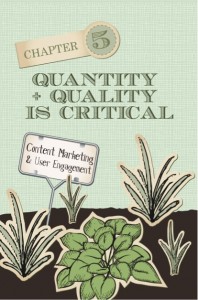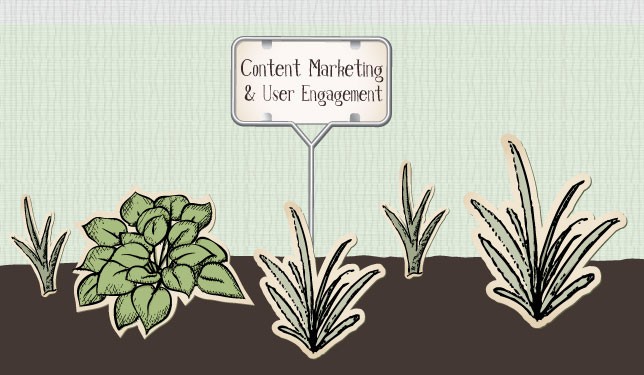Quantity + Quality Is Critical, Content Marketing & User Engagement
This all started with you, our customers and followers. At some point, every customer we have built a website for in the past 6 years asked us about search engine optimization (SEO) and wanted to know how to get their business’ website on the first page of Google. Naturally. Who wouldn’t want to know that?
The problem is that SEO is a highly complex topic. It’s not something you can explain to someone in a 20-minute call or a quick email. If it were quick and easy to optimize your website, everyone would do it, and then Google wouldn’t be able to rank anyone or say who deserves to be first, second, third and so on.
Because the technology behind search engine algorithms is so complex and ever changing, I wanted to find a better way to explain the basic concepts to our customers, business owners and nonprofits in a way that is memorable and easy to understand. Introducing…the garden metaphor. This metaphor helps explain some of the major factors in search engine ranking. First we started working on an infographic about SEO using the garden metaphor, but it eventually evolved into an ebook and then a print book.
This article is an excerpt from the book:
 A website with only four pages of content is like a garden with only four plants. The goal must always be to consistently create an abundance of high quality content to drive visitors and keep them engaged for as long as possible.
A website with only four pages of content is like a garden with only four plants. The goal must always be to consistently create an abundance of high quality content to drive visitors and keep them engaged for as long as possible.
Gardens are made up of a wide variety of vegetation and other materials, which I will call “content.” The vegetation might contain a combination of flowers, plants, shrubs, trees and grass. The other elements might be rocks, bricks, gravel paths, fencing, etc. The more variety you showcase, the more people will enjoy it.
On a website, content includes text, videos, graphics, photos, animation, buttons, navigation elements and so on. The number one thing you can do to improve your SEO is to develop high quality content for your website.
Quantity
Wikipedia.org website contains nearly 35 million pages of content! Obviously this is an extreme example to point out that you need content on your website. Lots of it! The more pages, the better. A website that has dozens of pages of good content will rank higher than a 5-page site if all other factors are the same. A 5-page site will rank higher than a 1-page site. This is why simple “landing pages” with nothing but basic contact information are largely obsolete. With hardly any content or text on the page, you might not even be able to rank on the first page of Google when someone local searches for your business name! That is the ultimate failure in search engine optimization.
One way to get more content is to reorganize, expand and optimize what you already have. Let’s say you are selling 10 different types of vegetable seeds on your site. You could compile all 10 types of the seeds on one long page. There is nothing wrong with this. But for SEO, it would be better to have a page for each type of seed. In addition, you should have a page displaying all 10 varieties with links to individual pages (carrot seeds, cucumber seeds and so on). So for example, you might have a small picture of carrot seeds with the words “carrot seeds” underneath. Both the photo and text link to a page like www.yourgardensite.com/carrot-seeds. This multi-page setup gives you more opportunities to optimize each page for one specific type of seed. The carrot page will be more likely to rank when someone Googles “carrot seeds” than a page that has all 10 types of seeds on it.
Quality
Having a lot of content is important, but it’s not enough. It must also be quality content. Your garden should be made up of healthy plants that are well cared for. No one wants to walk through a garden totally overgrown with weeds or full of wilting plants. And no one wants to go to a place that boasts a butterfly garden to show up and discover there are no butterflies.
Your website pages should be well written and have substantial quality content that people actually want to read or consume. If your content is helpful, newsworthy, complete, interesting, original or entertaining, people are more likely to spend time reading or consuming your content. Using visual elements and videos will please your visitors, while cramming your content full of ads will annoy them.
Google “Panda” refers to the algorithm changes that (among other things) helped weed out websites with low-quality content. The most notably affected websites were ones with lots of ads along with weak article content. An example of weak content would be if your headline and on-page SEO indicate the page is about “The Top 5 Lawn Mowers of 2015” but the page actually just contains links to a bunch of lawnmower websites or ads and no actual reviews of lawnmowers. An example of great content is one that advertises “The Top 5 Lawn Mowers of 2015” and actually provides a detailed review of each of the top five lawn mowers with product specs, pricing, photos and links on where to find more information.
“Content marketing” is a marketing technique of creating and distributing valuable and relevant content to attract, acquire and retain customers. Instead of pitching your products or services, you provide information that helps your visitors in some way. At the heart of this marketing strategy is the idea that if your business supplies consistent, ongoing valuable information to buyers, they will ultimately reward you with their business and loyalty.
Blogging
The best opportunity a business owner has to create and add content to their website—without having to be a website code ninja— is by using a Content Management System (CMS) to add content in a blog format. Examples of CMS’s are WordPress, Joomla, Drupal or Expression Engine.
If adding a blog to your website is going to help your SEO, it needs to actually “live” on your website (not on BlogSpot.com, Blogger.com or the like). Much like a street address, a URL (Uniform Resource Locator) is like a unique address on the Internet telling people where to find a specific page. The URL of your blog should be something like: www.yourdomain.com/blog. When users visit your blog, they should be on your website, not on an external site. You don’t want the URL of your blog to be something like: www.yourblog.blogger.com. This setup drives traffic and backlinks to www.blogger.com not www.yourdomain.com.
The best type of blog topics are ones your customers will care about and that include keywords that prospective customers will be searching for on Google, Bing and Yahoo. Identify your target audience, as well as what type of “persona” you are trying to attract. Then write articles and create content that you think would appeal to them.
Writing your thoughts or content around a topic that you have seen elsewhere is great. It’s fine to link to or reference another piece of content from your blog, so long as it’s interesting and high quality. But to maximize your SEO efforts, you want to make sure you’re mostly creating original content. I recommend your website should contain at least 75% original content, with 25% coming from syndicated content, article sharing, guest blogging or other sources.
Freshness
If writing a blog isn’t in your wheelhouse, then adding any other type of fresh content to your website is still helpful for your SEO. Keep your website up to date. That could include updating photos or information on the home page, adding new products, a photo gallery, more pages of detailed service or capabilities descriptions, a glossary of industry terms and regularly adding to your frequently asked questions. This is not an exhaustive list; almost any type of new, relevant content will help your Google ranking. Important note: When you add new content, be sure to share it—with a link—on Twitter, Facebook, Google+ and any other social media platforms you maintain. It will be indexed by the search engines that much more quickly.
The more frequently you blog or add new content to your website, the better. Just like when you are gardening, if you continue to plant new seeds or bulbs every month, your garden will continue to expand and flourish. If you plant new seeds every week, your garden will grow that much faster. And as some of the plants mature, you will start to reap the fruits of your labor.
Sore Thumb SEO
Never copy and paste an article (or other content) from some other website and put it on your site without permission and proper credit. You will get penalized by Google for “scraping” content from someone else’s website. Not to mention, you could also introduce legal issues from stealing content if the original author discovers it.
25 Blog Ideas: High Quality Content for Your Website
- How-to articles (these can be quick how-to’s or longer how-to’s broken into a series or articles)
- How-to videos or screencasts
- Frequently asked questions with detailed explanations
- Vocabulary or terminology explanations (you can reference these or link to them in other articles or from your email communications)
- Announcements of upcoming events such as tradeshows, training events, speaking engagements, conferences, etc.
- Personnel highlights or interviews with staff and management
- Announcements of work anniversaries or milestones from your company (“we just reached 1,000 customers” or “we are celebrating 10 years in business”)
- A look back at when you started your business and how it has evolved
- Explanation of your business core values
- Analysis, summaries or takeaways of past events or trainings
- Feedback, reviews or synopses of articles or books you read in print publications (make sure to properly credit the original author)
- Opinion articles or reviews about industry trends or news
- Case studies of projects you have worked on with anecdotes of lessons learned and project takeaways
- Interviews with your clients (link to their website so they might link back or share your content)
- Product reviews or product comparisons
- Infographics explaining interesting or relevant topics
- Top 10 thought leaders in your industry you admire (link to their website so they might link back or share your content)
- Top 10 favorite projects of the year with a short synopsis of each
- Upcoming industry trend predictions
- A look at what has changed in your industry since a specific year
- Descriptions of your perfect customer personas
- Talk about why what you do is important
- Top 5 essential tools and resources for your industry or business
- Top 5 tools or resources for your audience to use
- Guest blog articles written by people with overlapping interests (these could be from customers, professors, overlapping industries, even competitors or industry peers)
Blogging Bonuses:
Adding quality content to your website will:
- Increase your overall traffic
- Increase the average time spent on your site
- Increase the number of people who find your site through keyword searches on Google
- Decrease your “bounce rate” in your analytics
- Show prospective clients that you are an expert in your field
- Help you beat your competitors in Google page ranking



